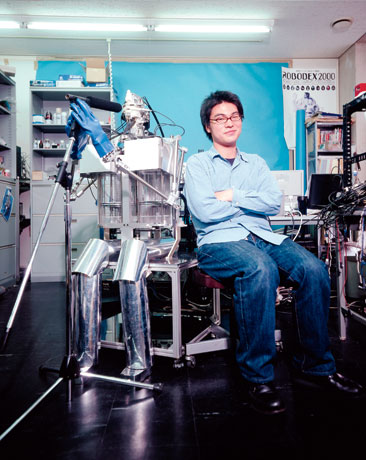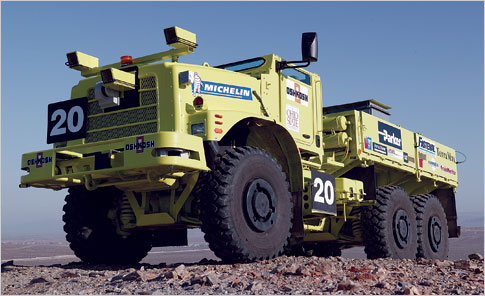

Click “View Photos” to meet the world’s most advanced humanoid precursors: a ‘bot with vocal cords, a mapmaking Segway, and more. And to hear more from Ray Kurzweil on his visionary predictions, subscribe to the PopSci Podcast (directions below).
Human experience is marked by a refusal to obey our limitations. We´ve escaped the ground, we´ve escaped the planet, and now, after thousands of years of effort, our quest to build machines that emulate our own appearance, movement and intelligence is leading us to the point where we will escape the two most fundamental confines of all: our bodies and our minds. Once this point comes-once the accelerating pace of technological change allows us to build machines that not only equal but surpass human intelligence-we´ll see cyborgs (machine-enhanced humans like the Six Million Dollar Man), androids (human-robot hybrids like Data in Star Trek) and other combinations beyond what we can even imagine.
Although the ancient Greeks were among the first to build machines that could emulate the intelligence and natural movements of people (developments invigorated by the Greeks´ musings that human intelligence might also be governed by natural laws), these efforts flowered in the European Renaissance, which produced the first androids with lifelike movements. These included a mandolin-playing lady, constructed in 1540 by Italian inventor Gianello Torriano. In 1772 Swiss watchmaker Pierre Jacquet-Droz built a pensive child named L´crivain (The Writer) that could write passages with a pen. L´crivain´s brain was a mechanical computer that was impressive for its complexity even by today´s standards.
Such inventions led scientists and philosophers to speculate that the human brain itself was just an elaborate automaton. Wilhelm Leibniz, a contemporary of Isaac Newton, wrote around 1700: â€What if these theories are really true, and we were magically shrunk and put into someone´s brain while he was thinking. We would see all the pumps, pistons, gears and levers working away, and we would be able to describe their workings completely, in mechanical terms, thereby completely describing the thought processes of the brain. But that description would nowhere contain any mention of thought! It would contain nothing but descriptions of pumps, pistons, levers!â€
Leibniz was on to something. There are indeed pumps, pistons and levers inside our brain-we now recognize them as neurotransmitters, ion channels and the other molecular components of the neural machinery. And although we don´t yet fully understand the details of how these little machines create thought, our ignorance won´t last much longer.
The word â€robot†originated almost a century ago. Czech dramatist Karel Capek first used the term in his 1921 play R.U.R. (for â€Rossum´s Universal Robotsâ€), creating it from the Czech word â€robota,†meaning obligatory work. In the play, he describes the invention of intelligent biomechanical machines intended as servants for their human creators. While lacking charm and goodwill, his robots brought together all the elements of machine intelligence: vision, touch sensitivity, pattern recognition, decision making, world knowledge, fine motor coordination and even a measure of common sense.
Capek intended his intelligent machines to be evil in their perfection, their perfect rationality scornful of human frailty. These robots ultimately rise up against their masters and destroy all humankind, a dystopian notion that has been echoed in much science fiction since.
The specter of machine intelligence enslaving its creators has continued to impress itself on the public consciousness. But more significantly, Capek´s robots introduced the idea of the robot as an imitation or substitute for a human being. The idea has been reinforced throughout the 20th century, as androids engaged the popular imagination in fiction and film, from Rosie to C-3PO and the Terminator.
The first generation of modern robots were, however, a far cry from these anthropomorphic visions, and most robot builders have made no attempt to mimic humans. The Unimate, a popular assembly-line robot from the 1960s, was capable only of moving its one arm in several directions and opening and closing its gripper. Today there are more than two million Roomba robots scurrying around performing a task (vacuuming) that used to be done by humans, but they look more like fast turtles than maids. Most robots will continue to be utilitarian devices designed to carry out specific tasks. But when we think of the word â€robot,†Capek´s century-old concept of machines made in our own image still dominates our imagination and inspires our goals.
For an interview with Ray Kurzweil, check out Episode 15 of the PopSci_ Podcast__. Subscribe via iTunes or RSS or download the MP3 directly with the links below._
The aspiration to build human-level androids can be regarded as the ultimate challenge in artificial intelligence. To do it, we need to understand not just human cognition but also our physical skill-it is, after all, a critical part of what the brain does. Coordinating intention with movement in a complex environment is largely the responsibility of the cerebellum, which comprises more than half the neurons in the brain. And the body itself represents much of our complexity: There is more information in the human genome, which describes the human body, than in the design of the brain.
We are making tremendous strides toward being able to understand how the brain works. The performance/price ratio, capacity and bandwidth of every type of information technology, electronic and biological alike, is doubling about every year. I call this pervasive phenomenon the law of accelerating returns. Our grasp of biology is proceeding at an accelerating pace, also exponentially increasing every year. It took scientists five years to be able to sequence HIV, for example, but the SARS virus required only 31 days. The amount of genetic data that´s been sequenced has doubled every year since the human genome project began in 1990, and the cost per base pair has come down by half each year, from $10 in 1990 to about a penny today. We are making comparable gains in understanding how the genome expresses itself in proteins and in understanding how a broad range of biological mechanisms work. Indeed, we are augmenting and re-creating nearly every organ and system in the human body: hearts and pancreases, joints and muscles.
The same progression applies to
our knowledge of the human brain.
The three-dimensional resolution of brain scans has been exponentially increasing, and the latest generation
of scanners can image individual neuronal connections firing in real time. The amount of data that scientists are gathering on the brain is similarly increasing every year. And they are showing that this information can be understood by converting it into models and simulations of brain regions, some two dozen of which have already been completed. IBM also recently began an ambitious effort to model a substantial part of the cerebral cortex in incredible detail.
If we are to re-create the powers of the human brain, we first need to understand how complex it is. There are 100 billion neurons, each with thousands of connections and each connection containing about 1,000 neural pathways. I´ve estimated the amount of information required to characterize the state of a mature brain at thousands of trillions of bytes: a lot of complexity.
But the design of the brain is a
billion times as simple as this. How
do we know? The design of the human brain-and body-is stored in the genome, and the genome doesn´t contain that much information. There
are three billion rungs of DNA in the human genome: six billion bits, or 800 million bytes. It is replete with redundancies, however; one lengthy sequence called ALU is repeated 300,000 times. Since we know the genome´s structure, we can compress its information to only 30 million to 100 million bytes, which is smaller than the code for Microsoft Word. About half of this contains the design of the human brain.
The brain can be described in just 15 million to 50 million bytes because most of its wiring is random at birth. For example, the trillions of connections in the cerebellum are described by only a handful of genes. This means that most of the cerebellum wiring in the infant brain is chaotic. The system is designed to be self-organizing, though, so as the child learns to walk and talk and catch a fly ball, the cerebellum gets filled with meaningful information.
My point is not that the brain is simple, but that the design is at a level of complexity that we can fathom and manage. And by applying the law of accelerating returns to the problem of analyzing the brain´s complexity, we can reasonably forecast that there will be exhaustive models and simulations of all several hundred regions of the human brain within about 20 years.
Once we understand how the mind operates, we will be able to program detailed descriptions of these principles into inexpensive computers, which, by the late 2020s, will be thousands of times as powerful as the human brain-another consequence of the law of accelerating returns. So we will have both the hardware and software to achieve human-level intelligence in a machine by 2029. We will also by then be able to construct fully humanlike androids at exquisite levels of detail and send blood-cell-size robots into our bodies and brains to keep us healthy from inside and to augment our intellect. By the time we succeed in building such machines, we will have become part machine ourselves. We will, in other words, finally transcend what we have so long thought of as the ultimate limitations: our bodies and minds.
Inventor and futurist Ray Kurzweil is the author of five books, including, most recently, The Singularity Is Near: When Humans Transcend Biology
For an interview with Ray Kurzweil, check out Episode 15 of the PopSci_ Podcast__. Subscribe via iTunes or RSS or download the MP3 directly with the links below._
























